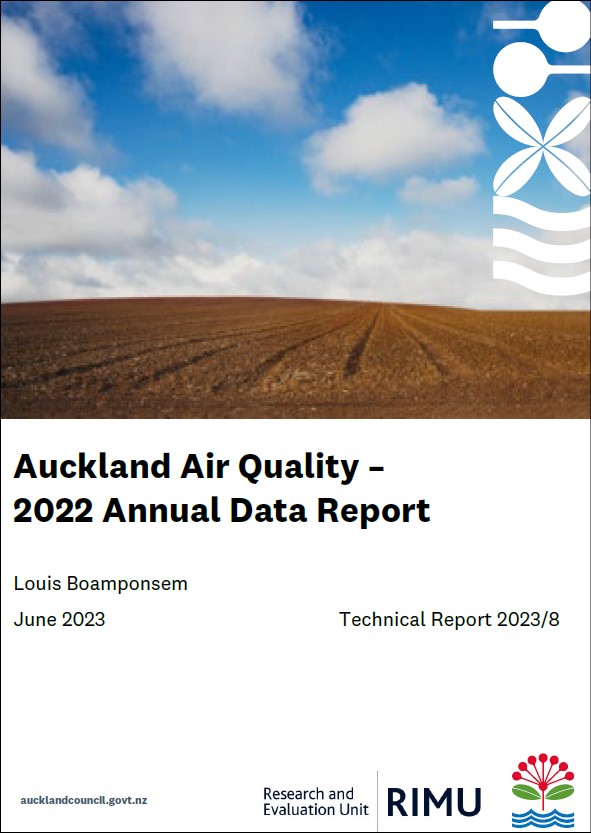Auckland air quality – 2022 annual data report
Author:
Louis BoamponsemSource:
Auckland Council Research and Evaluation Unit, RIMUPublication date:
2023Topics:
EnvironmentExecutive summary
Air pollution is a significant environmental hazard globally, posing a severe risk to human health. According to recent estimates from the World Health Organization (WHO), air pollution is responsible for around seven million deaths annually. People with pre-existing respiratory and heart conditions, diabetes, the young, and elderly individuals are particularly susceptible to the adverse effects of air pollution. In Auckland alone, air pollution was responsible for 939 premature deaths in 2016, and the associated social cost of PM2.5 and NO2 air pollution was estimated at $4.45 billion. Air pollution has a detrimental impact on the atmosphere and climate, as some pollutants have warming and cooling properties, contributing to climate change.
Auckland is located on an isthmus between the Tasman Sea and the South Pacific Ocean, benefiting from a relatively clean and dependable airflow due to the absence of any nearby landmasses to the east or west of the city. However, despite these favourable conditions, certain human activities in Auckland still contribute to air pollution levels that exceed national and international standards, posing a threat to public health.
Transportation, residential heating, and industrial emissions are the primary sources of anthropogenic air pollutants in Auckland. The Auckland Council is responsible for managing air quality in the region, as mandated by the Resource Management Act 1991 and the National Environmental Standards for Air Quality (NESAQ). To achieve this, the council conducts continuous air quality monitoring, enabling it to assess compliance, develop policies, and evaluate their effectiveness. The council's data collection efforts help to quantify ambient air quality across the region, including spatial and temporal variations. The key air pollutants monitored in Auckland include particulate matter (PM10 and PM2.5), black carbon, carbon monoxide (CO), nitrogen dioxide (NO2), ozone (O3), sulphur dioxide (SO2), and volatile organic compounds.
Data and information from the Auckland air quality monitoring network is reported in multiple ways. Monthly reports are regularly published on the Knowledge Auckland website, www.knowledgeauckland.org.nz. Data is available on the RIMU Environmental Data Portal, www.environmentauckland.org.nz and technical reports are produced in specific reporting years. This is the annual data report for 2022 data and its assessment against the NESAQ, Auckland Unitary Plan air quality target, and the 2021 WHO air quality guidelines.
Key findings:
- The annual average PM10 concentration of Auckland in 2022 increased by 2.5% compared to 2021. However, this increase did not exceed the 2021 WHO air quality guideline of 15 μg/m3 . The Queen Street site average exceeded the WHO guideline by 28.7%. On 18-19 August, the Queen Street site recorded two exceedances of NESAQ for PM10 (24-hour average). After further investigation, it was found that these exceedances were primarily due to a marine aerosol (sea salt) natural-source event.
- The overall annual average PM2.5 concentration of Auckland in 2022 increased by 2.8% compared to 2021. This increase was above the 2021 WHO air quality guideline of 5 μg/m3. Queen Street, Takapuna, Penrose and Patumahoe sites annual PM2.5 averages exceeded the WHO guideline. The Auckland Unitary Plan air quality target (25 μg/m3) for 24-hour average PM2.5 was not exceeded.
- In general, Auckland’s annual mean concentration of NO2 marginally decreased by 0.2% compared to 2021. As expected, the highest NO2 concentrations were measured at the city centre sites, although the concentrations were lower than the previous year. There were NO2 breaches of both the national standard and WHO guideline at the Customs Street and Khyber Pass Road sites. These exceedances were not true representations of the wider emissions profile in the areas monitored by these sites. The Customs Street site NO2 standard breaches were caused by exhaust fumes from a diesel power generator which was temporarily located near the monitoring station. Our investigation of the Khyber Pass Road site's NO2 national standard exceedance suggests that emissions from a stationary vehicle and spray paint fumes from a tag graffiti artist were the likely causes.
- The average concentration of SO2 in Auckland significantly increased by 40.8% in 2022 compared to 2021, which requires further investigation to identify the underlying cause of this rise.
- The average CO concentration at the Khyber Pass Road site decreased by 14.5% compared to 2021. This decrease can be attributed to the reduction in traffic in that area. There was no exceedance of NESAQ and the 2021 WHO air quality guideline for CO.
- The average O3 concentration at Patumahoe in 2022 increased by 9.0% compared to 2021. Though there were occasional hourly spikes in O3 mean concentrations, none were above the national standard and the 2021 WHO air quality guidelines for O3.
- All key air pollutants were highest in winter, most likely due to domestic fires. ...
Auckland Council technical report, TR2023/8
June 2023
See also
Auckland air quality – 2021 annual data report
